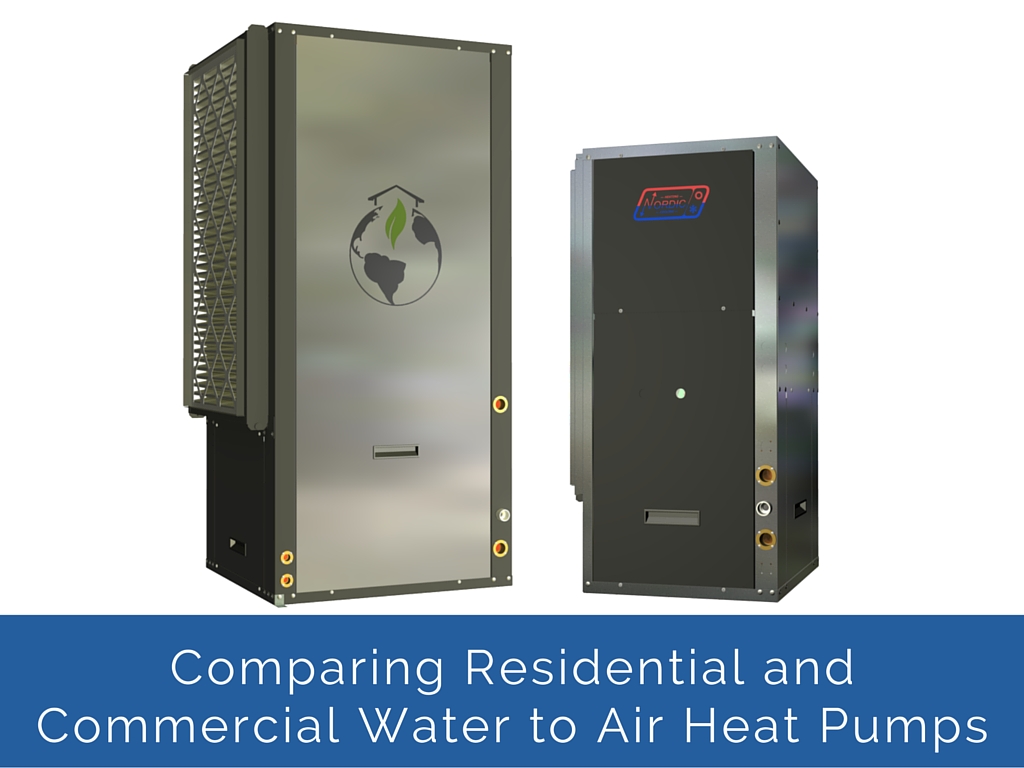When we began manufacturing heat pumps in 1983, we started with the simplest heat pump possible. We named it the “O” Series and it offered forced air heating and passive cooling. The second heat pump we added to our product lineup was the “R” Series, which was a standard water to air heat pump. This heat pump quickly became our most popular product due to its simple and effective design. Like all typical water to air heat pumps, it offered forced air heating and air conditioning, with desuperheating capabilities to preheat domestic hot water.
Today, the R Series is still one of our most popular machines, even though we’ve added dozens of products to our lineup since it was introduced. We’ve improved it, streamlined it, and added new features, and in 2015, we added an second version.
This year we introduced a variation of the traditional R Series heat pump that is ideally suited to commercial applications. Although the two units are similar, they have several key differences that make the original R Series more suited to fully detached homes, and the new R Series more suited to commercial applications like apartment buildings or condos. Here are the key differences between the two systems, which we’ll call the R Series Residential and the R Series Commercial from now on.
Capacity
The first and most obvious change between the R Series Residential and the R Series Commercial is the capacity of the units. Capacity is the term we use to describe how much heat the unit can put out. The R Series Residential has a capacity of 2 to 6.5 nominal tons, which means it can heat a home between 800 and 3,500 square feet in size.
In contrast, the R Series Commercial was originally designed for apartment buildings and condos, so it has a smaller capacity. This heat pump is available in sizes from 0.75 to 2 nominal tons, which can heat a space from 300 to 1,000 square feet in size.
I should note that in the future, we plan to expand the R Series Commercial line right up to 6.5 nominal tons.
Cabinet Size
The R Series Residential has a few more features and options, so the cabinet for this machine is bigger. The R Series Residential has a footprint of 24″ by 28″ and is 60″ tall.
The R Series Commercial heat pump was designed to be as compact as possible so that it can fit in a closet space or small mechanical room. Because of this, we’ve designed the machine to be a mere 19″ by 19″ by 42″ tall.
Compressor
The two machines also have different compressors. The R Series Residential has a two-stage Copeland scroll compressor while the R Series Commercial has a single stage LG rotary compressor. We made this change because Copeland’s smallest compressor size is 1.5 nominal tons, and we needed a smaller size than that.
Cabinet Configuration
The R Series Residential has a completely powder coated cabinet, while the R Series Commercial is only partially coated. In addition, the R Series Commercial is completely serviceable from one side, while the R Series Residential is serviceable from two sides.
The single-side serviceability of the R Series Commercial means it can be installed in a space where only one side is accessible, such as a closet. The R Series Residential is typically installed in a basement where dual side serviceability is convenient.
Desuperheating
The R Series Residential is equipped with a desuperheater. A desuperheater preheats your domestic hot water, helping you save up to 50% on domestic hot water heating. The R Series Commercial is not equipped with a desuperheater as standard equipment, which helps keep this unit more economical in cost. As a result, the R Series Commercial unit provides only ducted heating and cooling, with no desuperheating capability.
Price
The R Series Residential includes all of the bells and whistles you’d expect in a premium geothermal heat pump. It’s visually attractive and has slightly better performance. But those extra features come at a price, which is why the R Series Residential is slightly more expensive.
The R Series Commercial, on the other hand, is designed specifically for large scale applications where the machine will be out of sight and will perform simpler functions. This makes this unit slightly less expensive than its residential cousin.
To find out more about these machines, visit their product pages:
Or download our Ebook to find out six ways geothermal heat pumps can benefit your commercial building.


